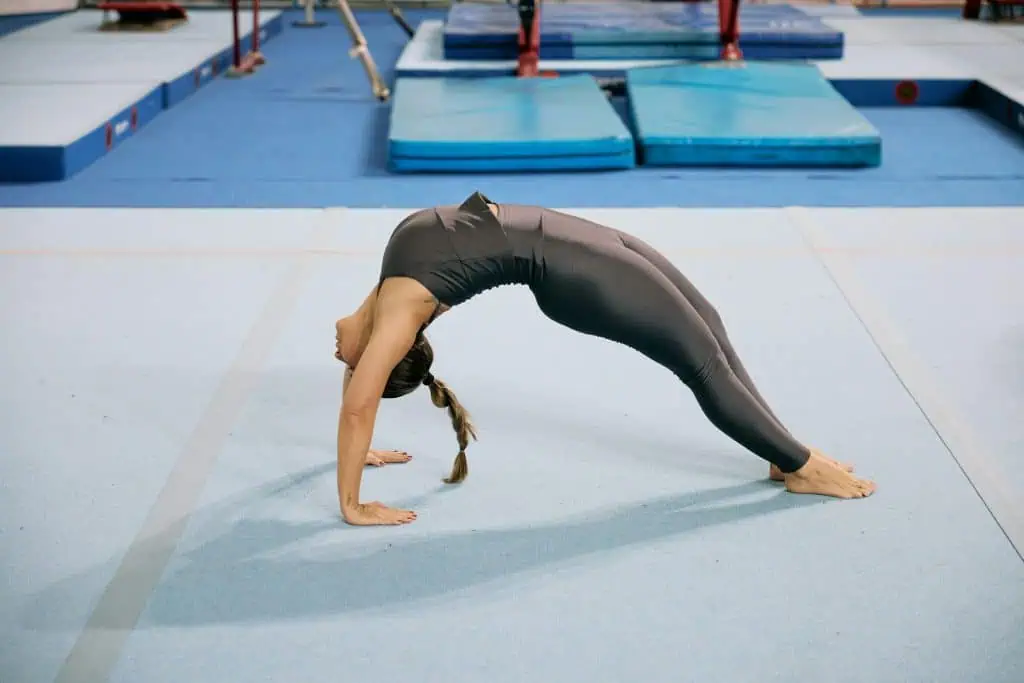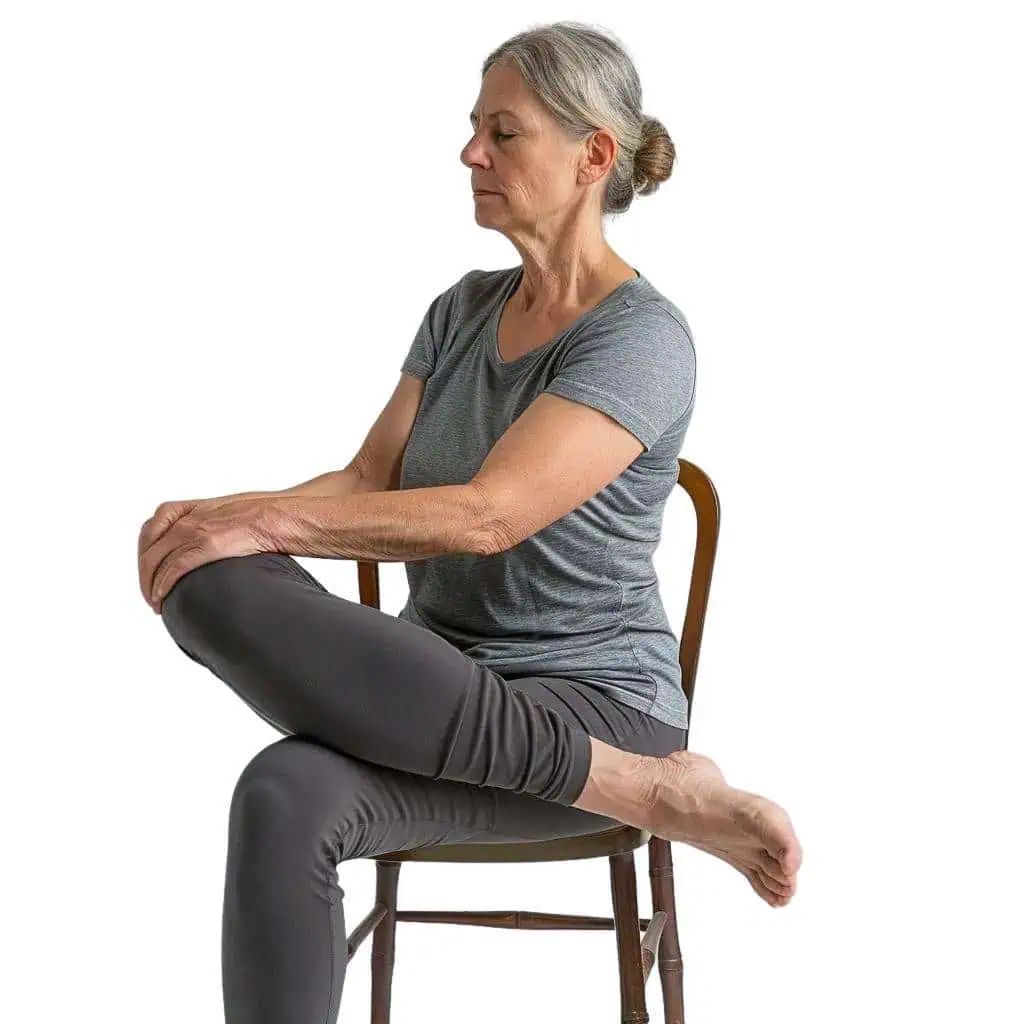Are you tired of back pain and stiffness? The backward stretch might be just what you need. This simple yet effective exercise can help improve flexibility and ease discomfort in your back, pelvis, and thighs.
By incorporating the backward stretch into your daily routine, you can enjoy better posture and reduced back pain.

We’ll explore how to do the backward stretch correctly and safely.
The backward stretch starts on your hands and knees and involves curling backward toward your heels. It’s a gentle way to stretch your back muscles and can be done by people of all fitness levels.
Let’s dive into the details of this helpful stretch and learn how it can benefit your overall health and well-being.
Key Takeaways
- The backward stretch can improve back flexibility and reduce pain
- Proper form is crucial for getting the most out of this exercise
- Regular practice can lead to better posture and increased comfort
Benefits of Backward Stretching
Backward stretching offers several advantages for physical and mental well-being. It helps improve flexibility, boosts blood flow, relaxes muscles, and reduces stress. Let’s explore these benefits in more detail.
Improved Flexibility
Backward stretching can increase flexibility in the back muscles. We find that regular practice helps lengthen tight muscles along the spine and shoulders.
This improved flexibility can lead to better posture and reduced risk of injury.
To get started, try this simple stretch:
- Lie on your back with knees bent
- Tighten your stomach muscles
- Lift your lower back off the floor
- Hold for 5 seconds, then relax
- Repeat 5-30 times daily
As flexibility improves, we often notice increased range of motion in daily activities.
Enhanced Circulation
Backward stretches promote better blood flow throughout the body. When we stretch, blood vessels expand, allowing more oxygen and nutrients to reach our muscles and organs.
Improved circulation benefits include:
- Faster muscle recovery
- Reduced inflammation
- Better overall body function
One effective stretch for circulation is the cat-cow pose. This gentle movement alternates between arching and rounding the back, encouraging blood flow along the spine.
Muscle Relaxation
Backward stretching helps relax tense muscles in the back, neck, and shoulders. We often hold stress in these areas, leading to pain and discomfort.
Regular stretching can release this tension and promote muscle relaxation.
A simple supine twist can target multiple muscle groups:
- Lie on your back with knees bent
- Drop knees to one side
- Turn head in opposite direction
- Hold for 30 seconds
- Repeat on other side
This stretch gently rotates the spine, helping to relax muscles along its length.
Stress Relief
We find that backward stretching can significantly reduce stress levels. The slow, controlled movements and deep breathing associated with stretching help calm the mind and body.
Stretching exercises trigger the release of endorphins, our body’s natural stress-fighters. These feel-good chemicals help improve mood and reduce anxiety.
To maximize stress relief, try incorporating mindfulness into your stretching routine:
- Focus on your breath
- Pay attention to how each stretch feels
- Let go of tension with each exhale
Techniques and Execution
Backward stretches can be very helpful for improving flexibility and reducing back pain. We’ll cover key points to maximize the benefits of these stretches while minimizing injury risk.
Proper Alignment
When doing backward stretches, we need to pay close attention to our body position. Keep the feet hip-width apart and pointing forward.
Engage the core muscles to support the lower back.
Tuck the chin slightly to maintain a neutral neck position. This helps avoid straining the neck muscles.
We should focus on arching through the upper back, not just bending at the waist.
Place hands on the lower back for support if needed. This can help guide the movement and provide stability. Always move slowly and with control.
Breathing Patterns
Proper breathing is crucial for effective stretching. We recommend taking slow, deep breaths throughout the stretch.
Inhale deeply through the nose as you prepare to stretch backward.
Exhale slowly through the mouth as you arch back. This helps relax the muscles and can increase the stretch.
Hold the stretch for 15-30 seconds while continuing to breathe steadily.
Avoid holding your breath, as this can create tension in the body. If you feel dizzy or lightheaded, return to the starting position and focus on your breathing.
Progressive Intensity
Start with gentle backward stretches and gradually increase intensity over time.
We suggest beginning with small movements and short hold times. As flexibility improves, slowly extend the range of motion and duration.
Listen to your body and never push into pain. A mild stretch sensation is normal, but sharp or intense pain means you’ve gone too far.
Use techniques like hold-relax to safely increase flexibility.
Consistency is key. Regular practice will yield better results than occasional intense sessions. Aim for daily stretching, even if it’s just for a few minutes each time.
Safety Considerations
Backward stretches can be helpful, but they come with risks. We need to be careful to avoid hurting ourselves. Let’s look at how to stretch safely and when to be extra cautious.
Understanding Limitations
Our bodies are all different. Some people can bend more than others. It’s key to know your own limits. Don’t try to match what others can do.
Listen to your body when stretching. If it hurts, stop. Pain is a warning sign. Mild discomfort is okay, but sharp pain is not.
We should start slow and build up over time. Our flexibility will improve with regular practice. But it takes time. Don’t rush it.
Preventing Injury
Warm up before stretching. Cold muscles are more likely to get hurt. A short walk or light exercise can help.
Don’t bounce when stretching. Hold each stretch for 15-30 seconds instead. Bouncing can cause muscle tears.
Breathe normally while stretching. Holding our breath can make muscles tense up. Relaxed muscles stretch better.
Use proper form. Bad form can hurt us. If we’re not sure how to do a stretch, we should ask a trainer or doctor.
When to Avoid
We shouldn’t stretch if we have a recent injury. Let it heal first. Stretching too soon can make things worse.
If we have chronic back pain, talk to a doctor before doing backward stretches. Some conditions make these stretches risky.
Avoid stretching if we’re very tired. Fatigue can make us less aware of our limits. This raises the risk of overdoing it.
Don’t stretch cold muscles. Always warm up first. Cold stretching is a common cause of muscle strains.
Frequently Asked Questions
Back stretches can help relieve pain and improve flexibility. We’ll address common questions about effective techniques for different areas of the back, safety considerations, and specific stretches to target problem areas.
What are effective stretches for relieving lower back pain?
The kneeling back extension can help ease tension in the lower back. Another useful stretch is the knee-to-chest. Lie on your back, gently pull one knee toward your chest, and hold for 30 seconds. Repeat with the other leg.
Cat-cow stretches are also great for the lower back. Start on your hands and knees, arch your back up like a cat, then lower it while lifting your head. Do this slowly 5-10 times.
How can I safely perform upper back stretches?
For upper back stretches, start with gentle movements. The shoulder blade squeeze is a safe option. Sit or stand with good posture, then pull your shoulder blades together. Hold for 5 seconds and release. Repeat 10 times.
Another safe stretch is the wall angel. Stand with your back against a wall, raise your arms to shoulder height, and slide them up and down. This helps improve posture and stretch the upper back muscles.
Can backward stretching help alleviate neck pain?
Yes, backward stretching can help with neck pain. The chin tuck is a simple but effective stretch. Gently tuck your chin down and in toward your chest. Hold for 5-10 seconds, then release. Repeat 10 times.
The neck rotation stretch is also helpful. Slowly turn your head to one side until you feel a gentle stretch. Hold for 10 seconds, then repeat on the other side. Do this 5 times on each side.
What precautions should pregnant women take when performing back stretches?
Pregnant women should avoid lying flat on their backs after the first trimester. Instead, they can do modified stretches while sitting or standing. Always check with a doctor before starting any new exercise routine during pregnancy.
Gentle cat-cow stretches on hands and knees are usually safe and can help relieve back pain. Pelvic tilts while standing against a wall are also good for pregnant women.
How can one improve flexibility in the hamstrings using seated stretches?
The seated forward curl is great for hamstring flexibility. Sit on the floor with legs extended. Slowly reach for your toes, bending from the hips. Hold for 15-30 seconds.
Another option is the seated one-leg hamstring stretch. Sit with one leg extended and the other bent. Reach for the toes of the extended leg. Hold for 15-30 seconds, then switch legs.
Are there specific stretches recommended for loosening tight lower back muscles?
The supine twist is excellent for tight lower back muscles. Lie on your back, bend your knees, and lower them to one side while keeping your shoulders flat. Hold for 20-30 seconds, then switch sides.
Child’s pose is another great stretch. Kneel on the floor, sit back on your heels, then reach your arms forward, lowering your chest to the ground. Hold for 30 seconds to 1 minute.









